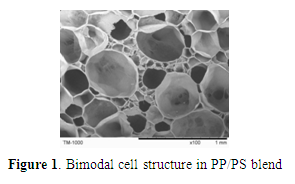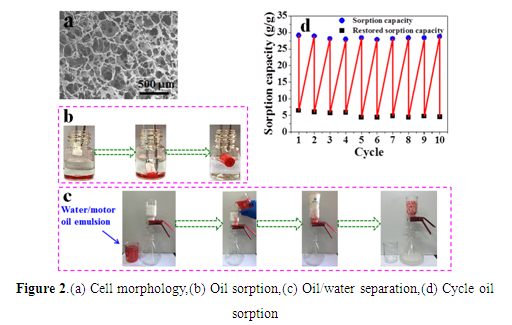Driven by the global advocacy of green development, traditional modes of production and process are facing challenges of transformation and upgradation. Developing advanced processing technologies that can reduce energy consumption and emission of harmful pollutants has been called worldwide for an economic, environmental-friendly and sustainable path to a better future. Continuous extrusion foaming with supercritical CO2 (scCO2) combines the characteristics of non-toxicity of a green foaming agent and large-scale production of a continuous extrusion process, which make it indeed environmental-friendly, efficient and of continuous production compared with other foaming processes. Moreover, as a supercritical fluid, scCO2 shows a high diffusion rate and a high mass transfer rate as well as a plasticizing effect to polymers, which allow it to be a good candidate as a green medium for polymer processing to lower the viscosity of polymer melts and decrease the processing temperature and thus to lower energy consumption. Recently, the advanced polymer processing group from Ningbo Institute of Materials Technology and Engineering, Chinese Academy of Sciences (NIMTE, CAS) has made a series of progresses on continuous extrusion foaming and polymer processing with the polymer processing platform using scCO2, a self-designed pilot-scale extrusion system built in 2007.
1. Polymer foams with bimodal cell structures have shown good properties in end uses in many fields, such as packing, tissue engineering, sound absorption and insulation, etc. However, preparation of bimodal cell structures in polymer blends in continuous extrusion foaming has still remained a challenging task. Researchers from the advanced polymer processing group have successfully prepared bimodal cell structures in polypropylene/polystyrene (PP/PS) blends via adjusting the cell nucleation ability in two phases in continuous extrusion foaming (Figure 1). This new foaming technique is expected to satisfy and boost great demand in polymer blend foams with bimodal cell structures. Moreover, it would also provide advances and insights in theoretical supports for preparing bimodal cell structures in other polymer blends (Patent: 201510940039.6; The Journal of Supercritical Fluids, 2016).

2. Offshore oil spill and discharge of industrial waste oil have caused severe ecological and environmental problems. Developing oil sorbents with a high oil sorption capacity, good oil/water selectivity and good reusability could satisfy the requirements from various applications. Foams with high open cell content (more than 90%) were prepared with polypropylene/polyolefin elastomer (PP/POE) blends in continuous extrusion foaming. The foams showed good oleophilic and hydrophobic properties, good oil/water separation, high oil sorption capacities, and good reusability in sorption tests with organic solvents, edible oil and motor oil, etc (Figure 2). Therefore, they have demonstrated potential in such applications as oil/water separation, industrial wastewater treatment and oil cleanup on the sea (Patents: 201510392352.0 and 201510392373.2).
 .
.
3. Generally, linear PP can hardly be well foamed due to its relatively low melt strength. To improve its foaming behaviors, preparation of long-chain branched PP with higher melt strength via reactive extrusion is a feasible approach. However, the processing temperature of reactive extrusion is usually very high, which would induce severe polymer degradation and would thus deteriorate the physical properties of modified PP. With utilization of scCO2 working both as the reactive medium and the foaming agent, on one hand, polymer degradation was prominently hindered, attributed to the lower processing temperature, and on the other, well-defined cell structures were obtained in modified PP, attributed to the higher melt strength rendered by the long-chain branching formed during the mild reactive extrusion. Therefore, it provided an advanced foaming approach via preparation of long-chain branched PP through reactive extrusion with scCO2 working as both the reactive medium and the foaming agent (Patent: 201510108423.X; Journal of Materials Science, 2016).
4. It is an effective approach to enhance the physical properties of polymer blends via improving the dispersion states. However, for this purpose, interfacial compatibilization is usually required. Recent studies by the advanced polymer processing group from NIMTE, CAS have showed that, without interfacial modification, improved dispersion was achieved by adjusting the melt viscosity ratio of two components in PP/PS (Polymer Bulletin, 2016) and PP/POE (Patent: 201610117411.8) blends in the presence of scCO2. Foamability of the blends was significantly improved, and mechanical properties were also improved to some extent. In addition, in-situ interfacial compatibilization for polymer blends via reactive extrusion is another effective approach for improving mechanical properties. However, the relatively high processing temperature would easily result in severe polymer degradation during the process. Therefore, reactive extrusion under mild conditions is thus demanded to inhibit polymer degradation. A novel strategy was designed to use scCO2 as the medium for the process, allowing the reactive extrusion to be conducted at a relatively lower processing temperature that caused less degradation. Consequently, interfacial compatibilization and mechanical properties were prominently improved for PP/PS blends. (Patent: 201510560530.6).
Prof. Wenge Zheng: wgzheng@nimte.ac.cn
Associate Prof. Yongyan Pang: yongyan.pang@nimte.ac.cn
Polymers and Composites Division
All Images by ![]()

